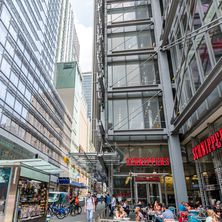

Although the north-south 8th Avenue is usually very congested during working hours, and in certain tracts may not be the most attractive thoroughfare in Manhattan, it does connect several important points of interest. In the evening it is also the fastest way to get uptown by car while remaining in the center and not having to take the peripheral highways.
The avenue is actually known by different names in various parts of Manhattan, despite the fact that it is a straight continuous thoroughfare. It starts in the West Village, deriving from Hudson Street, and carries traffic uptown for about fifty streets, passing through Chelsea, the Garment District, Hell's Kitchen and the Broadway theater district, until swerving around Columbus Circle at the southwestern corner of Central Park and turning into Central Park West. As it borders the western edge of the park, it is a two-way avenue and after the park at 110th Street it becomes Frederick Douglass Boulevard, continuing to 155th Street, where it stops by the Harlem River.
In Greenwich Village it is popular for being the venue of New York's annual gay pride parade, which takes place at the southernmost part of the avenue. In midtown it runs past Penn Station and the Port Authority Bus Terminal. Before the 1990s the section between 42nd and 50th Streets was infested with red-light theaters, shops and parlors. The most elegant part of 8th Avenue is without doubt the stretch known as Central Park West, which is home to some of the city's most prestigious and expensive apartment buildings - the Dakota, the Majestic and San Remo just to name three. It loses its grandeur as it transforms into Frederick Douglass Boulevard and enters the neighborhood of Harlem.
But such is New York in general: diverse, multifaceted, multilayered and full of surprises.